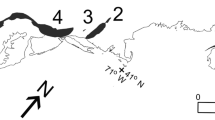Abstract
THE observation of anomalously high iridium concentrations at the Cretaceous/Tertiary (K/T) boundary1 triggered the still unresolved debate concerning the origin of sedimentary Ir anomalies. Several hypotheses have been presented, including meteorite impacts1,2 and intense volcanism3,4. Here we present data from the Acraman impact ejecta horizon, South Australia5, which conclusively links high sedimentary iridium concentrations to a major meteoroid-impact structure and its widely dispersed ejecta. An Ir anomaly (up to 2 parts per 109 (p.p.b.) Ir as well as Au, Pt, Pd, Ru and Cr anomalies) is present within the ejecta from the Acraman impact event preserved in late Precambrian (∼600 Myr BP) shales within the Adelaide Geosyncline. The highest Ir (and Cr) concentrations within the ejecta are associated with the coarsergrained clasts of acid volcanics (boulder to medium-sand size) suggesting that most of the Ir is carried by these fragments. The target rocks at the impact site are comparable acid volcanics that have very low Ir, Au, Pt, Pd, Ru and Cr concentrations, indicating a meteoritic origin for the anomalous Ir levels within the ejecta. To our knowledge, this is the first example in which an accepted, widely dispersed impact-ejecta blanket, itself uniquely linked to a major terrestrial impact structure5,6 has been shown to be anomalously high in cosmogenic siderophile elements. This finding strongly supports the hypothesis that Ir anomalies in sediments can be produced by terrestrial meteorite impact events.
This is a preview of subscription content, access via your institution
Access options
Subscribe to this journal
Receive 51 print issues and online access
$199.00 per year
only $3.90 per issue
Buy this article
- Purchase on Springer Link
- Instant access to full article PDF
Prices may be subject to local taxes which are calculated during checkout
Similar content being viewed by others
References
Alvarez, L. W., Alvarez, W., Asaro, F. & Michel, H. V. Science 208, 1095–1108 (1980).
Kyte, F. T., Zhou, Z. & Wasson, J. T. Nature 288, 651–656 (1980).
Officer, C. B. & Drake, C. L. Science 227, 1161–1167 (1985).
Crocket, J. H., Officer, C. B., Wezel, F. C. & Johnson, G. D. Geology 16, 77–88 (1988).
Gostin, V. A., Haines, P. W., Jenkins, R. J. F., Compston, W. & Williams, I. S. Science 233, 198–200 (1986).
Williams, G. E. Science 233, 200–203 (1986).
Kyte, F. T., Zhou, L. & Wasson, J. T. Science 241, 63–65 (1988).
Williams, G. E. Search 18, 143–145 (1987).
Compston, W., Williams, I. S., Jenkins, R. J. F., Gostin, V. A. & Haines, P. W. Aust. J. Earth Sci. 34, 435–445 (1987).
Fanning, C. M., Flint, R. B., Parker, A. J., Ludwig, K. R. & Blissett, A. H. Precambr. Res. 40/41, 363–386 (1988).
Hoaston, D. M. & Keays, R. R. Econ. Geol. (in the press).
Anders, E. & Ebihara, M. Geochim. cosmochim. Acta 46, 2363–2380 (1982).
Kyte, F. T., Smit, J. & Wasson, J. T. Earth planet. Sci. Lett. 73, 183–195 (1985).
Strong, C. P. et al. Geochim. cosmochim. Acta 51, 2769–2777 (1987).
Lerbekmo, J. F. & St. Louis, R. M. Can. J. Earth Sci. 23, 120–124 (1986).
Brooks, R. R. et al. Science 226, 539–542 (1984).
Gilmore, J. S., Knight, J. D., Orth, C. J., Pillmore, C. L. & Tschudy, R. H. Nature 307, 224–228 (1984).
Ganapathy, R. Science 209, 921–923 (1980).
Author information
Authors and Affiliations
Rights and permissions
About this article
Cite this article
Gostin, V., Keays, R. & Wallace, M. Iridium anomaly from the Acraman impact ejecta horizon: impacts can produce sedimentary iridium peaks. Nature 340, 542–544 (1989). https://doi.org/10.1038/340542a0
Received:
Accepted:
Issue Date:
DOI: https://doi.org/10.1038/340542a0
This article is cited by
-
A critical review of the case for, and against, extraterrestrial impact at the K/T boundary
Surveys in Geophysics (1990)
Comments
By submitting a comment you agree to abide by our Terms and Community Guidelines. If you find something abusive or that does not comply with our terms or guidelines please flag it as inappropriate.



